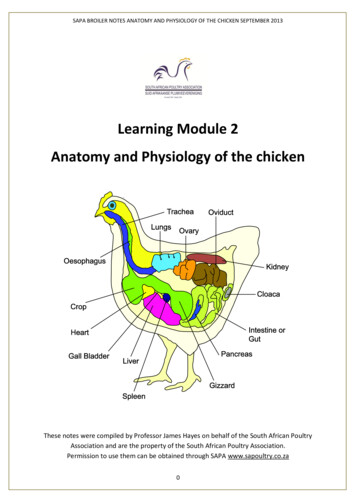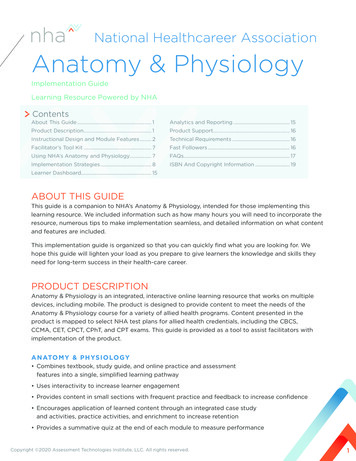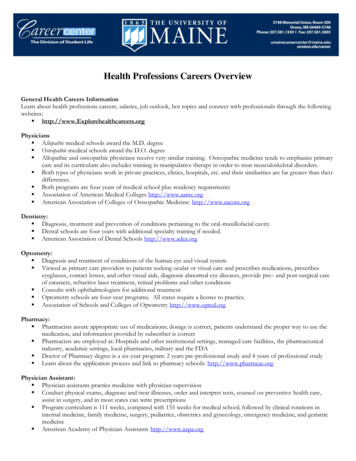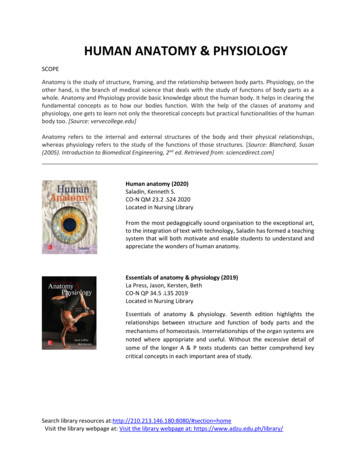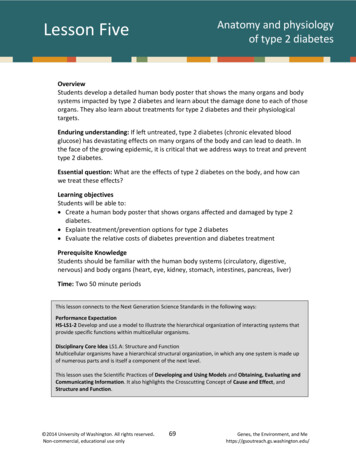
Transcription
Anatomy and physiologyof type 2 diabetesLesson FiveOverviewStudents develop a detailed human body poster that shows the many organs and bodysystems impacted by type 2 diabetes and learn about the damage done to each of thoseorgans. They also learn about treatments for type 2 diabetes and their physiologicaltargets.Enduring understanding: If left untreated, type 2 diabetes (chronic elevated bloodglucose) has devastating effects on many organs of the body and can lead to death. Inthe face of the growing epidemic, it is critical that we address ways to treat and preventtype 2 diabetes.Essential question: What are the effects of type 2 diabetes on the body, and how canwe treat these effects?Learning objectivesStudents will be able to: Create a human body poster that shows organs affected and damaged by type 2diabetes. Explain treatment/prevention options for type 2 diabetes Evaluate the relative costs of diabetes prevention and diabetes treatmentPrerequisite KnowledgeStudents should be familiar with the human body systems (circulatory, digestive,nervous) and body organs (heart, eye, kidney, stomach, intestines, pancreas, liver)Time: Two 50 minute periodsThis lesson connects to the Next Generation Science Standards in the following ways:Performance ExpectationHS-LS1-2 Develop and use a model to illustrate the hierarchical organization of interacting systems thatprovide specific functions within multicellular organisms.Disciplinary Core Idea LS1.A: Structure and FunctionMulticellular organisms have a hierarchical structural organization, in which any one system is made upof numerous parts and is itself a component of the next level.This lesson uses the Scientific Practices of Developing and Using Models and Obtaining, Evaluating andCommunicating Information. It also highlights the Crosscutting Concept of Cause and Effect, andStructure and Function. 2014 University of Washington. All rights reserved.Non-commercial, educational use only69Genes, the Environment, and Mehttps://gsoutreach.gs.washington.edu/
TeacherPagesLesson Five: Anatomy and physiology of type 2 diabetesMaterialsMaterialsComputer and projectorLesson 5 PowerPoint presentation, found at:https://gsoutreach.gs.washington.edu/Computer and internet accessLarge piece of butcher block paper, big enough to make a life-sizedbody outline of a student5 colors of construction paper, one for each body group (heart, brain,eyes, kidneys, and limbs)Student Sheet 5: Organs affected by type 2 diabetes (two-sided)Student Resource: On-line Reference Guide (this could be cut intostrips)Quantity1 per class1 per classPer group1 per class1 color pergroup1 per student1 per groupLesson Preparation Prepare a life-sized body outline before class, or have butcher paper available to do so atthe beginning of class by tracing a student. Make sure that students have access to computers and the internet. Have Lesson 5 PowerPoint presentation ready to be projected.Presenting the LessonPart 1 (Engage):Type 2 diabetes: a growing epidemic(10 minutes)1. Show students PowerPoint Slide 1 to introduce the lesson to students.Slide 12. Read the statement below to your class, or project slide 2 of the PowerPoint.If current trends continue, 1 in 3 U.S. adults will have diabetes by 2050.Source: Center for Disease Control and Prevention, ations/aag/ddt.htm 2014 University of Washington. All rights reserved.Non-commercial, educational use only70Genes, the Environment, and Mehttps://gsoutreach.gs.washington.edu/
TeacherPagesLesson Five: Anatomy and physiology of type 2 diabetesSlide 23. Ask students to work in pairs to briefly discuss: What do you know about the effects of type 2 diabetes on the body? How are these symptoms treated? What would happen if 1 in 3 adults in the U.S. had type 2 diabetes?4. As a class, discuss and record student responses to the three prompts. Ask students whataspects of the symptoms/effects of t2d they would like to learn more about, and recordthese questions.Part 2 (Explore):Organs affected by type 2 diabetes(30 minutes)5. Make (or show) one full-sized body poster made of butcher paper for the class to use. Hangthe poster in a place that is accessible to students. Ideally, the poster could be left up for theduration of the unit, so that the class could continue to add information to the poster.6. Use Slide 3 to give a body overview and discuss the body organs and systems affected by type2 diabetes. Refer back to the symptoms/effects students mentioned earlier, when possible.Slide 3Note: Teachers may wish to have class teamsresearch and report back on more than fiveorgans affected by type 2 diabetes. TheTeacher Resource at the end of this lessonsuggests additional organs or organ systemsthat are affected, such as the pancreas, skin,lungs, stomach, intestines, and others.7. Hand out Student Sheet 5: Organs affected by type 2 diabetes. Tell student that they will beworking in teams to learn more about each organ listed on Table 1 and on the slide.8. Split the class into 5 groups and assign each group an organ to research in more detail.Alternately, the class could be split into 10 or more groups, with two groups findinginformation about the same organ. 2014 University of Washington. All rights reserved.Non-commercial, educational use only71Genes, the Environment, and Mehttps://gsoutreach.gs.washington.edu/
Lesson Five: Anatomy and physiology of type 2 diabetesTeacherPages9. Hand out the Student Resource: On-line Reference Guide to each group (or hand out the stripof paper pertaining to their organ). This will be used to further research the effects of type 2diabetes on that organ. Ideally, the links could also be provided in electronic form.10. Hand out a piece of colored paper to each group. This will be used to draw and cut out a lifesized organ to be attached to the life-sized poster.11. Have students begin researching in groups and record their findings for their organ on thefront side of Student Sheet 5: Organs affected by type 2 diabetes.12. When students have had enough time, students can report back to their classmates on whatthey have learned. Presenting students should come to the human body poster, attach theirorgan, and report back on their findings. The rest of the class can take notes on the organsother students have researched as they listen to their presentations.Note: This portion of the lesson can also be run as a jigsaw activity, in which studentswho have chosen the same organ first meet together to fully fill out the informationfor that organ on their tables on Student Resource 5. Students then regroup intomixed organ groups in order to teach each other about the other organs. Organs canbe attached to the human body poster after the jigsaw is complete.Part 3 (Explore/Explain): How high blood glucose causes damage (20 minutes)13. After student groups have presented to each other, ask if there are any common themesabout treatment and prevention (last column) across the different organs.Students may notice that damage to many of the organs can be prevented by loweringchronic high blood glucose level (controlling blood sugar) through lifestyle interventions likediet and exercise. Careful screening and medication may also play a part after diabetes hasdeveloped.14. Point out for students the first column of their data table. Why does it say Chronic High BloodGlucose?Although different organs may sustain different types of damage, the root cause of type 2diabetes is chronic high blood glucose levels. By controlling that, each organ can be affected.15. Ask students to look at the column that asks What causes the symptom? Do they see anycommon pathway to damage among the organs they have studied? What damaged bodysystems contribute to the damage in the organ they studied?Student may notice that damage to blood vessels is a common theme. They may also noticethat damage to nerves (neuropathy) contributes to damage in other organs. 2014 University of Washington. All rights reserved.Non-commercial, educational use only72Genes, the Environment, and Mehttps://gsoutreach.gs.washington.edu/
TeacherPagesLesson Five: Anatomy and physiology of type 2 diabetes16. Use Slides 4 through 7 to discuss three major ways that high blood glucose and other changesin type 2 diabetes cause damage to cells, organs, and body systems. Slide 4 shows three typesof primary damage that have a cascade effect on many organs.Slide 417. Slides 5 – 7 describe each of the mechanisms in more detail.Slide 5Slide 6Slide 718. Ask students to work with their groups to relate these mechanisms to the organ they studied.If time allows, students could add this to the human body poster. 2014 University of Washington. All rights reserved.Non-commercial, educational use only73Genes, the Environment, and Mehttps://gsoutreach.gs.washington.edu/
TeacherPagesLesson Five: Anatomy and physiology of type 2 diabetes19. Show students slides 8 through 10. While treatments of all three of these mechanisms arebeing studied, none provides a perfect, or even good, solution.Slide 8Slide 9Slide 10Part 4 (Elaborate):Treatment and cost(20 minutes)20. Show students Slide 11. Underscore for students that the physiological mechanisms theyhave seen in this lesson are complex and interrelated, which makes treatment difficult andexpensive. The green arrows show primary damage caused by the three mechanisms, andthe purple arrows show the effects of damage to nerves, capillaries, and large blood vesselsto other organs.Slide 11 2014 University of Washington. All rights reserved.Non-commercial, educational use only74Genes, the Environment, and Mehttps://gsoutreach.gs.washington.edu/
TeacherPagesLesson Five: Anatomy and physiology of type 2 diabetes21. Share with students some of the financial costs of type 2 diabetes, per year. These statisticsare from the year 2007, which was the latest year this information was available: Direct medical costs for t2d: 116 billion Indirect costs (related to disability, work loss, premature death): 58 billion Total costs (direct and indirect): 174 billion On average, medical expenses for a person with diagnosed diabetes are more thantwice as much as the expenses of a person without diabetes.Source: CDC, ations/aag/ddt.htm22. Show students Slides 12 and 13. Discuss the question, and point out that both preventionand treatment can start with the control of chronic elevated levels of blood glucose, throughdiet, exercise, and medication to help reduce insulin resistance.Slide 13Slide 1223. Type 2 diabetes puts a financial burden on individuals, families, communities, and healthcare systems. Money needs to be invested in treatment options for people living with type 2diabetes and, at the same time, money needs to be invested in prevention so that people donot become diabetic. Prevention, in the long run, is more cost effective than treating theeffects of type 2 diabetes.Closure (Evaluate)24. Revisit the statement made at the beginning of the class:(10 minutes)If current trends continue, 1 in 3 U.S. adults will have diabetes by 2050.25. Ask students how old they will be in 2050. If prevention is more desirable than treatment,and they will be about 50 years old in 2050, at what point in time should their 50 year-oldself take steps to prevent diabetes?26. Ask students how this lesson contributes to their understanding of the Driving Question:How can the growth of type 2 diabetes in the Yakima Valley be slowed? and revisit theQuestion Wall to see if questions have been answered or more questions need to be added.Please allow students time to work in groups on their Call to Action products. It will take aclass period or two for groups to assimilate and integrate new information into their product,as well as refine their Call to Action plan. A Group Planning Worksheet and other resourcescan be found in the Assessment section at the end of this unit. 2014 University of Washington. All rights reserved.Non-commercial, educational use only75Genes, the Environment, and Mehttps://gsoutreach.gs.washington.edu/
Lesson FiveStudentResourceOn-line Reference GuideHeartNational Heart, Lung, and Blood opics/topics/dhd/National Diabetes Information Clearinghouse e/#occurAmerican Diabetes Association: ications/heart-disease/WebMD: Risks and complications in heart and blood vessels: ncontrolled-diabetesGenetic Health http://www.genetichealth.com/DBTS Diabetes Controlling Type 2 Diabetes.shtml#Anchor2BrainNational Diabetes Information Clearinghouse (NDIC): rAmerican Diabetes Association: tmlThe Final Frontier: How Does Diabetes Affect the Brain? (advanced PMC2797942/EyesAmerican Diabetes Association ications/eye-complications/WebMD: Risks and complications in heart and blood vessels, eyes: ncontrolled-diabetesGenetic Health: http://www.genetichealth.com/DBTS Diabetes Controlling Type 2 Diabetes.shtml#Anchor2KidneysAmerican Diabetes Association: ications/kidney-diseasenephropathy.htmlDiabetic kidney disease: sease-leafletDiabetes and kidney disease: betes and kidney hcarticles.nsf/pages/Diabetes and kidney failureGenetic Health: http://www.genetichealth.com/DBTS Diabetes Controlling Type 2 Diabetes.shtml#Anchor2Feet (e.g. limbs)American Diabetes Association ications/foot-complications/Group Health item eDamage.html&print truePictures of organs and organ systems can be found at: www.diabetes.co.uk/body/ andhttp://commons.wikimedia.org/wiki/Human body diagrams 2014 University of Washington. All rights reserved.Non-commercial, educational use only76Genes, the Environment, and Mehttps://gsoutreach.gs.washington.edu/
StudentSheet 577.1aInstructions: Make a life-sized organ using the colored paper. Reseach the organ using the sources on the other side of this handout, and fill in thecorrect columns.Lesson FiveOrganOrgans affected by 2 diabetesFunction(what does it do?)What are some symptoms oftype 2 diabetes in this organ?(stroke, ulcers, blindness )What causes the symptom?(leaky blood vessels, decreasedcirculation )Chronic High Blood GlucoseHeartBrainEyesKidneysLimbs(e.g. feet)Use the back of the sheet for additional space if needed. 2014 University of Washington. All rights reserved.Non-commercial, educational use only77Genes, the Environment, and Mehttps://gsoutreach.gs.washington.edu/How can the organ damage be treatedor prevented? (screening, lifestylechanges, surgery, medicine )
StudentSheet 5Question:77.1aGiven a hypothetical 1 million dollars that you must spend to benefit the community in regards to type 2 diabetes, how would you spend theLesson FiveOrgans affected by 2 diabetesmoney? Why? Make sure to mention both prevention and treatment in your answer.(Since it is difficult to know exactly how much things cost, you may use percentages, such as: I would spend 50% of the money on prevention by building play grounds inelementary school so that school kids can get exercise, and 50% of the money on treatment by making sure that people without health insurance have the medication theyneed.)Additional notes: 2014 University of Washington. All rights reserved.Non-commercial, educational use only78Genes, the Environment, and Mehttps://gsoutreach.gs.washington.edu/
TeacherPagesLesson Five: Anatomy and physiology of type 2 diabetesTeacher Resource: Effect of Diabetes on Human Body Systems and OrgansOrgan /StructureBody SystemFunctionEffect of diabetesHeartCardiovascularThe function of the heart, agrapefruit-sized organ, is topump oxygen-rich bloodthroughout your body andoxygen-poor blood to yourlungs.High Blood Pressure (Hypertension): As many as 2 out of 3 adults with diabetes have high blood pressure (hypertension). Because of the risks of high blood pressure to people with diabetes, the AmericanDiabetes Association and the National Institutes of Health recommend a lowerblood pressure target than the general public (less than 130/80 mmHg). Hypertension raises risk for heart attack, stroke, eye problems, and kidney disease. Blood pressure can be controlled with lifestyle changes, such as diet and exercise,and medication.BrainNervousWith information in the form ofnerve impulses, the brain isable to monitor and regulateunconscious body processes,such as digestion and breathingand to coordinate mostvoluntary movements of yourbody.Dementia:From large epidemiological studies, it has been demonstrated that both vascular andAlzheimer's dementia are more common in patients with type 2 diabetes.Your eyes are connected toyour brain and are dependentupon the brain to interpretwhat we see. It consists of thecornea, iris, lens, macula, opticnerve, pupil, retina, and otherstructures.The kidneys, a pair of dark redbean-shaped, fist-sized organs,make urine from wasteproducts and excess water inthe blood, and keep your bloodcomposition constant (e.g.water, pH and salt).Blindness:Most blindness in U.S. adults is caused by diabetes (diabetic retinopathy). Diabeticretinopathy happens when diabetes damages the tiny blood vessels inside your retina,the light sensitive tissue at the back of the eye.EyeNervous SystemKidneysUrinary 2014 University of Washington. All rights reserved.Non-commercial, educational use only79Stroke: 2 out of 3 people with diabetes die from stroke or heart disease. A stroke occurs when blood supply to part of your brain is interrupted and braintissue is damaged, resulting in paralysis, problems with thinking or speaking, oremotional problems.Kidney Disease: High blood sugar can overwork kidneys, causing them to stop working properly, andcan result in excess sugar and proteins leaking into the urine. When diagnosed later, kidney failure usually results.Genes, the Environment, and Mehttps://gsoutreach.gs.washington.edu/
TeacherPagesLesson Five: Anatomy and physiology of type 2 diabetesFeetAppendage(contains structuresfrom variousdifferent bodysystems)Your feet allow for mobility.Nerve damage, as a result of high blood sugar, from diabetes can cause you to losefeeling in your feet. You may not feel a cut, a blister or a sore. Foot injuries such asthese can cause ulcers and infections. Serious cases may even lead to amputation.Damage to the blood vessels can also mean that your feet do not get enough bloodand oxygen. It is harder for your foot to heal, if you do get a sore or infection.PancreasDigestive/EndocrineThe function of the pancreas isto secrete enzymes (digest fats,proteins, and carbohydrates)and hormones (insulin andglucagon) that control bloodsugar levels.Sustained high blood sugar (hyperglycemia), occurring in all types of diabetes,increases blood fats. Constant exposure of the beta cells (insulin-producing cells in thepancreas) to blood fats is thought to prompt an inflammatory effect. Though not wellunderstood, sustained inflammation appears to reduce insulin production (by thepancreas) and possibly destroy the insulin-producing beta cells completely.Insulin lowers blood sugar byincreasing the intake of glucoseto cells (fat, muscle and livercells). Glucagon increasesblood sugar by triggering theliver to release glucose into selsCardiovascularSkin, the largest organ, is flat,pliable and tough, between 0.5and 4m thick. Its function is toprotect your body fromdamage, infection and dryingout.Your lungs are a pair of largesponge-like organs that almostfill your chest cavity, anddeliver oxygen to and removecarbon dioxide from yourblood.Blood vessels (arteries, veinsand capillaries) carry blood toand from the body. 2014 University of Washington. All rights reserved.Non-commercial, educational use only80Effect of Diabetes on Skin:At least 33% of people with diabetes will have a skin disorder caused or affected bydiabetes at some time in their lives, which is often the first sign of diabetes.Effect of Diabetes on the Lungs:It has been shown that lung damage, caused by type 1 and 2 diabetes, is the result ofdiabetic microangiopathy (damage to small blood vessels).Effect of Diabetes on Blood Vessels:High blood glucose levels cause the endothelial cells lining the blood vessels to take inmore glucose than normal. As a result, these cells form more glycoproteins on theirsurface than normal, and cause the basement membrane to grow thicker and weaker,causing them to bleed, leak protein, and slow the flow of blood through the body.Genes, the Environment, and Mehttps://gsoutreach.gs.washington.edu/
TeacherPagesLesson Five: Anatomy and physiology of type 2 diabetesStomachDigestiveThe function of the stomach, aJ-shaped elastic organ, isstoring food, breaking fooddown and mixing it with juicessecreted by its lining.Gastroparesis: Gastroparesis is a type of neuropathy (nerve damage) in which food is delayed fromleaving the stomach, due specifically to damage to the vagus nerve, and is caused bylong periods of high blood sugar. Delayed digestion makes the management of diabetes more difficult. It can be treated with insulin management, drugs, diet, or in severe cases, a feedingtube. This disorder affects people with both type 1 and 2 diabetes.LiverDigestiveThe liver (largest internalorgan), a wedge-shaped,spongy organ, gets rid oftoxins, regulates your bloodsugar levels and to producesbile. The liver regulates bloodsugar by responding to ahormone, glucagon, bybreaking down glycogen toglucose in liver cells, andreleasing the glucose to theblood. Liver storage cells storeglucose and glycogen (as domuscle cells).Hemochromatosis, an autosomal recessive inherited condition, characterized byelevated absorption of iron from the small intestine and excessive accumulation ofiron in the liver and other tissues. Patients with untreated hemochromatosis developprogressive liver disease, cirrhosis (hardening of the liver), and diabetes and are athigh risk for developing hepatocellular carcinoma (liver cancer).Note: The liver can also convert amino acids (building blocks of proteins) into glucose(gluconeogenesis) and fat into ketones for energy when blood glucose is low.BladderUrinaryThe bladder stores urine.When this organ stretchesbeyond a certain point, nervesin its wall send a message toyour brain telling it that thisorgan is getting full and needsto be emptied.Effect of Diabetes on the Bladder: Diabetes can affect the nerves that control the bladder, making it difficult for aperson to empty his or her bladder completely. Incomplete emptying of the bladder can result in the growth of bacteria in thebladder and the tubes leading from it, eventually causing infection. Without prompt examination and treatment by a doctor, the infection can reach thekidneys, causing pain, fever, and possibly kidney damage. 2014 University of Washington. All rights reserved.Non-commercial, educational use only81Genes, the Environment, and Mehttps://gsoutreach.gs.washington.edu/
TeacherPagesLesson Five: Anatomy and physiology of type 2 diabetesMuscleMuscularSkeletalMuscle accounts for abouthalf of a person’s weight.There are 3 types of these inyour body: voluntary, smoothand cardiac.NerveNervous1. Receive information fromthe sensory receptors,2. Transfer and interpretimpulses, and3. Send impulses to themuscles and glands.Effect of Diabetes on Muscles: Research has shown that “known and newly diagnosed diabetic older men havesignificantly weaker muscle strength and higher odds of impaired physical function thanthose without diabetes”. From this study, there appears to be a relationship between raised glucose levels, weakermuscle strength, and impaired physical function.If you have diabetes, your blood sugar levels are too high. Over time, this can damage thecovering on your nerves or the blood vessels that bring oxygen to your nerves. Damagednerves may stop sending messages, or may send messages slowly or at the wrong times.This damage is called diabetic neuropathy.What is Diabetic Neuropathy? Diabetic neuropathy is a peripheral (near the surface) nerve disorder caused by diabetesor poor blood sugar control. The most common types of diabetic neuropathy result in problems with sensation in thefeet. It can develop slowly after many years of diabetes or may occur early in the disease. The loss of sensation in the feet may also increase the possibility that foot injuries will gounnoticed and develop into ulcers or lesions that become infected, and can be associatedwith weakness in the foot muscles.Small andlargeintestineDigestiveThe small intestine, an organ,is a five meter long narrowtube that functions in thechemical digestion of foodand the absorption ofnutrients into your blood.The large intestine, an organ,is a 1.5 meter-long tube thatfunctions in converting foodwaste products into feces. Itis the final part of yourdigestive tract. 2014 University of Washington. All rights reserved.Non-commercial, educational use only82 Diabetes can also affect the autonomic nerves that control blood pressure, the digestivetract, bladder function, and sexual organs. Problems with the autonomic nerves may cause lightheadedness, indigestion, diarrhea orconstipation, difficulty with bladder control, and impotence.Longstanding diabetes can diminish the function the enteric nerves to the small intestine,leading to abnormal motility, secretion, or absorption. This can lead to bacterialovergrowth syndromes, resulting in diarrhea and abdominal pain.Though limited information is available, it is known that enteric neuropathy may affect thenerves of the colon, decreasing in colon motility and resulting in constipation.Genes, the Environment, and Mehttps://gsoutreach.gs.washington.edu/
organs affected by type 2 diabetes. The Teacher Resource at the end of this lesson suggests additional organs or organ systems that are affected, such as the pancreas, skin, lungs, stomach, intestines, and others. Slide 2 3. Ask students to work in pairs to briefly discuss: What do you know about the




